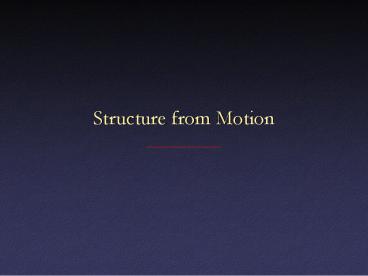Structure from Motion - PowerPoint PPT Presentation
Title:
Structure from Motion
Description:
Structure from Motion Structure from Motion For now, static scene and moving camera Equivalently, rigidly moving scene and static camera Limiting case of stereo with ... – PowerPoint PPT presentation
Number of Views:154
Avg rating:3.0/5.0
Title: Structure from Motion
1
Structure from Motion
2
Structure from Motion
- For now, static scene and moving camera
- Equivalently, rigidly moving scene andstatic
camera - Limiting case of stereo with many cameras
- Limiting case of multiview camera calibration
with unknown target - Given n points and N camera positions, have 2nN
equations and 3n6N unknowns
3
Approaches
- Obtaining point correspondences
- Optical flow
- Stereo methods correlation, feature matching
- Solving for points and camera motion
- Nonlinear minimization (bundle adjustment)
- Various approximations
4
Orthographic Approximation
- Simplest SFM case camera approximated by
orthographic projection
Perspective
Orthographic
5
Weak Perspective
- An orthographic assumption is sometimes well
approximated by a telephoto lens
Weak Perspective
6
Consequences ofOrthographic Projection
- Scene can be recovered up to scale
- Translation perpendicular to image planecan
never be recovered
7
Orthographic Structure from Motion
- Method due to Tomasi Kanade, 1992
- Assume n points in space p1 pn
- Observed at N points in time at image coordinates
(xij, yij), i 1N, j1n - Feature tracking, optical flow, etc.
8
Orthographic Structure from Motion
- Write down matrix of data
Points ?
Frames ?
9
Orthographic Structure from Motion
- Step 1 find translation
- Translation parallel to viewingdirection can not
be obtained - Translation perpendicular to viewing direction
equals motion of average position of all points
10
Orthographic Structure from Motion
- Subtract average of each row
11
Orthographic Structure from Motion
- Step 2 try to find rotation
- Rotation at each frame defines local coordinate
axes , , and - Then
12
Orthographic Structure from Motion
- So, can write where R is a
rotation matrix and S is a shape matrix
13
Orthographic Structure from Motion
- Goal is to factor
- Before we do, observe that rank( ) 3(in
ideal case with no noise) - Proof
- Rank of R is 3 unless no rotation
- Rank of S is 3 iff have noncoplanar points
- Product of 2 matrices of rank 3 has rank 3
- With noise, rank( ) might be gt 3
14
SVD
- Goal is to factor into R and S
- Apply SVD
- But should have rank 3 ?all but 3 of the wi
should be 0 - Extract the top 3 wi, together with the
corresponding columns of U and V
15
Factoring for Orthographic Structure from Motion
- After extracting columns, U3 has dimensions 2N?3
(just what we wanted for R) - W3V3T has dimensions 3?n (just what we wanted for
S) - So, let RU3, SW3V3T
16
Affine Structure from Motion
- The i and j entries of R are not, in general,
unit length and perpendicular - We have found motion (and therefore shape)up to
an affine transformation - This is the best we could do if we didntassume
orthographic camera
17
Ensuring Orthogonality
- Since can be factored as R S, it can also
be factored as (RQ)(Q-1S), for any Q - So, search for Q such that R R Q has the
properties we want
18
Ensuring Orthogonality
- Want or
- Let T QQT
- Equations for elements of T solve byleast
squares - Ambiguity add constraints
19
Ensuring Orthogonality
- Have found T QQT
- Find Q by taking square root of T
- Cholesky decomposition if T is positive definite
- General algorithms (e.g. sqrtm in Matlab)
20
Orthogonal Structure from Motion
- Lets recap
- Write down matrix of observations
- Find translation from avg. position
- Subtract translation
- Factor matrix using SVD
- Write down equations for orthogonalization
- Solve using least squares, square root
- At end, get matrix R R Q of camera
positionsand matrix S Q-1S of 3D points
21
Results
- Image sequence
Tomasi Kanade
22
Results
- Tracked features
Tomasi Kanade
23
Results
- Reconstructed shape
Front view
Top view
Tomasi Kanade
24
Orthographic ? Perspective
- With orthographic or weak perspective cant
recover all information - With full perspective, can recover more
information (translation along optical axis) - Result can recover geometry and full motion up
to global scale factor
25
Perspective SFM Methods
- Bundle adjustment (full nonlinear minimization)
- Methods based on factorization
- Methods based on fundamental matrices
- Methods based on vanishing points
26
Motion Field for Camera Motion
- Translation
- Motion field lines converge (possibly at ?)
27
Motion Field for Camera Motion
- Rotation
- Motion field lines do not converge
28
Motion Field for Camera Motion
- Combined rotation and translationmotion field
lines have component that converges, and
component that does not - Algorithms can look for vanishing point,then
determine component of motion around this point - Focus of expansion / contraction
- Instantaneous epipole
29
Finding Instantaneous Epipole
- Observation motion field due to translation
depends on depth of points - Motion field due to rotation does not
- Idea compute difference between motion of a
point, motion of neighbors - Differences should point towards instantaneous
epipole
30
SVD (Again!)
- Want to fit direction to all ?v (differences in
optical flow) within some neighborhood - PCA on matrix of ?v
- Equivalently, take eigenvector of A ?(?v)(?v)T
corresponding to largest eigenvalue - Gives direction of parallax li in that patch,
together with estimate of reliability
31
SFM Algorithm
- Compute optical flow
- Find vanishing point (least squares solution)
- Find direction of translation from epipole
- Find perpendicular component of motion
- Find velocity, axis of rotation
- Find depths of points (up to global scale)

